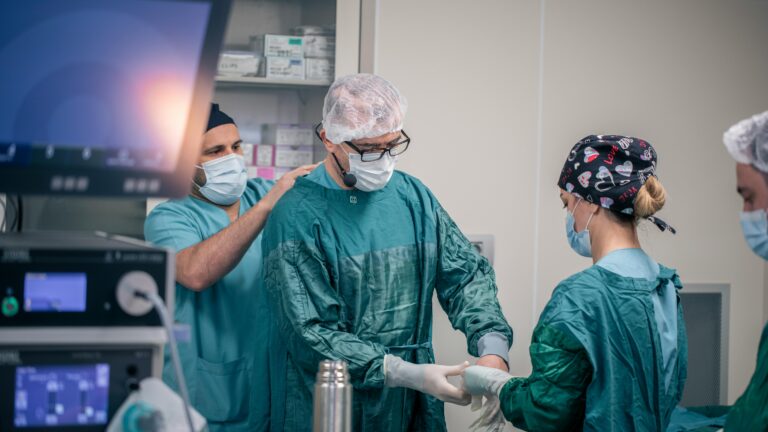When it comes to treating prostate cancer, robotic prostatectomy has emerged as a groundbreaking surgical option that combines precision, minimal invasiveness, and faster recovery times. If you or a loved one is considering this procedure, you’ve come to the right place. We’re here to break down everything you need to know about robotic prostatectomy, from how it works to what you can expect during recovery. Let’s dive in.
- What is Robotic Prostatectomy?
- Why Choose Robotic Prostatectomy Over Traditional Surgery?
- Who is a Candidate for Robotic Prostatectomy?
- What to Expect Before, During, and After the Procedure
- Robotic Prostatectomy Recovery Time
- What is the Success Rate of Robotic Prostatectomy?
- Average Cost of Robotic Prostatectomy
- Potential Risks and Complications
- Recovery Tips for a Smooth Healing Process
- Long-Term Outcomes of Robotic Prostatectomy
- Why Choose Us for Your Robotic Prostatectomy?
- Final Thoughts
- Studies Supporting the Efficacy of Robotic Prostatectomy
- FAQs: Robotic Prostatectomy
- Question: What is robotic prostatectomy?
- Question: How long does it take to recover from robotic prostatectomy?
- Question: What is the success rate of robotic prostatectomy?
- Question: What is the average cost of robotic prostatectomy?
- Question: What are the risks of robotic prostatectomy?
- Question: How is the patient positioned during robotic prostatectomy?
- Question: Can robotic prostatectomy preserve urinary and sexual function?
- Question: Is robotic prostatectomy covered by insurance?
- Question: How long does the robotic prostatectomy procedure take?
- Question: Who is a good candidate for robotic prostatectomy?
What is Robotic Prostatectomy?
Robotic prostatectomy is a minimally invasive surgical procedure used to remove the prostate gland in cases of prostate cancer. This advanced technique utilizes the da Vinci Surgical System, a state-of-the-art robotic platform that allows surgeons to perform complex procedures with enhanced precision, flexibility, and control. Unlike traditional open surgery, robotic prostatectomy involves smaller incisions, reduced blood loss, and a quicker recovery period.
The procedure is performed by a highly skilled urologist who controls the robotic arms from a console. The robotic system translates the surgeon’s hand movements into smaller, more precise movements of tiny instruments inside the body. This level of precision is particularly beneficial when operating in delicate areas like the prostate, which is surrounded by nerves and blood vessels critical for urinary and sexual function.
Why Choose Robotic Prostatectomy Over Traditional Surgery?
When comparing robotic prostatectomy to traditional open surgery, the advantages are clear. Here’s why this cutting-edge procedure is often the preferred choice:
- Minimally Invasive Approach: Robotic surgery requires only a few small incisions, reducing the risk of infection and scarring.
- Enhanced Precision: The 3D high-definition visualization and wristed instruments of the da Vinci system allow for unparalleled accuracy.
- Reduced Blood Loss: The precision of the robotic system minimizes damage to surrounding tissues, leading to less bleeding.
- Faster Recovery: Patients typically experience shorter hospital stays and a quicker return to normal activities.
- Lower Risk of Complications: The procedure’s precision reduces the likelihood of damage to nearby nerves and muscles, preserving urinary and sexual function.
Who is a Candidate for Robotic Prostatectomy?
Not everyone with prostate cancer is a candidate for robotic prostatectomy. The procedure is typically recommended for men with localized prostate cancer that has not spread beyond the prostate gland. Factors such as overall health, age, and the stage of cancer play a significant role in determining eligibility. A thorough evaluation by a urologist is essential to determine if this procedure is the right choice for you.
What to Expect Before, During, and After the Procedure
Before the Procedure
Preparation for robotic prostatectomy involves a series of steps to ensure the best possible outcome. Your medical team will conduct a comprehensive evaluation, including blood tests, imaging studies, and a review of your medical history. You may be advised to stop certain medications, such as blood thinners, and to follow a specific diet in the days leading up to surgery.
During the Procedure
On the day of surgery, you’ll be placed under general anesthesia. The surgeon will make a few small incisions in your abdomen to insert the robotic instruments and a camera. Using the da Vinci console, the surgeon will carefully remove the prostate gland and surrounding tissues if necessary. The entire procedure typically takes 2 to 4 hours, depending on the complexity of the case.
Robotic Prostatectomy Positioning
Proper positioning during robotic prostatectomy is critical for the success of the procedure. Here’s how it’s done:
- Patient Position: The patient is placed in a Trendelenburg position, which means lying on their back with the head tilted downward at a 30- to 45-degree angle. This position allows the abdominal organs to shift away from the surgical area, providing better access to the prostate.
- Legs: The legs are often placed in stirrups to ensure stability and prevent movement during the procedure.
- Arms: The arms are typically tucked at the sides to avoid interference with the robotic arms.
- Padding: Special padding is used to protect pressure points and prevent nerve damage during the surgery, which can last 2 to 4 hours.
After the Procedure
Recovery from robotic prostatectomy is generally faster than traditional surgery. Most patients can expect to stay in the hospital for 1 to 2 days. You’ll be encouraged to walk as soon as possible to promote healing and prevent blood clots. Pain is usually manageable with prescribed medications, and you’ll receive detailed instructions on wound care, diet, and activity restrictions.
Robotic Prostatectomy Recovery Time
One of the most significant advantages of robotic prostatectomy is its faster recovery time compared to traditional open surgery. Here’s what you can expect:
- Hospital Stay: Most patients are discharged within 1 to 2 days after the procedure.
- Return to Normal Activities: Light activities, such as walking, can usually be resumed within 1 to 2 weeks. However, strenuous activities or heavy lifting should be avoided for 4 to 6 weeks.
- Full Recovery: Most men feel back to normal within 4 to 6 weeks, though complete healing of internal tissues may take up to 3 months.
- Urinary Continence: While some men may experience temporary urinary incontinence, 90% regain full bladder control within 12 months.
- Sexual Function: Recovery of erectile function varies, but many men see improvement within 6 to 12 months, especially with nerve-sparing techniques.
What is the Success Rate of Robotic Prostatectomy?
The success rate of robotic prostatectomy is highly encouraging, with outcomes often surpassing those of traditional open surgery. Key statistics include:
- Cancer Control: Studies show that robotic prostatectomy achieves negative surgical margins (no cancer left behind) in 85-90% of cases, a key indicator of successful cancer removal.
- Survival Rates: For localized prostate cancer, the 10-year survival rate is approximately 95%.
- Urinary Continence: About 90% of men regain full bladder control within 12 months.
- Sexual Function: With nerve-sparing techniques, 50-80% of men recover erectile function within 1 to 2 years, depending on age and pre-surgery function.
- Patient Satisfaction: Over 90% of patients report being satisfied with their decision to undergo robotic prostatectomy, citing faster recovery and fewer complications.
Average Cost of Robotic Prostatectomy
The cost of robotic prostatectomy can vary widely depending on factors such as geographic location, hospital fees, surgeon experience, and insurance coverage. Here’s a general breakdown:
- United States: The average cost ranges from $10,000 20,000, including hospital fees, surgeon fees, and anesthesia. Without insurance, the cost can exceed $30,000.
- Europe: In countries like the UK or Germany, the cost is typically lower, ranging from €8,000 to €15,000.
- Insurance Coverage: Most insurance plans, including Medicare, cover robotic prostatectomy if it is deemed medically necessary. However, out-of-pocket expenses such as deductibles and co-pays may apply.
Potential Risks and Complications
While robotic prostatectomy is considered safe, like any surgical procedure, it carries some risks. These may include:
- Infection: Although rare, infections can occur at the incision sites.
- Bleeding: Some blood loss is expected, but significant bleeding is uncommon.
- Urinary Incontinence: Temporary or, in rare cases, permanent loss of bladder control may occur.
- Erectile Dysfunction: Depending on the extent of nerve involvement, some men may experience changes in sexual function.
It’s important to discuss these risks with your surgeon to fully understand the potential outcomes and how they can be managed.
Recovery Tips for a Smooth Healing Process
To ensure a smooth recovery after robotic prostatectomy, follow these tips:
- Stay Active: Gentle walking can help prevent complications like blood clots.
- Follow Your Doctor’s Instructions: Adhere to all post-operative guidelines, including medication schedules and activity restrictions.
- Stay Hydrated: Drinking plenty of water can help flush out your system and promote healing.
- Eat a Balanced Diet: Focus on nutrient-rich foods to support your body’s recovery.
- Attend Follow-Up Appointments: Regular check-ups are crucial to monitor your progress and address any concerns.
Long-Term Outcomes of Robotic Prostatectomy
The long-term outcomes of robotic prostatectomy are highly encouraging. Studies have shown that the procedure effectively removes cancerous tissue while preserving quality of life. Most men experience a significant improvement in urinary and sexual function within a year of surgery. Additionally, the risk of cancer recurrence is low, especially when the procedure is performed by an experienced surgeon.
Why Choose Us for Your Robotic Prostatectomy?
When it comes to robotic prostatectomy, expertise matters. Our team of board-certified urologists has extensive experience performing this advanced procedure. We combine cutting-edge technology with a patient-centered approach to ensure the best possible outcomes. From your initial consultation to your final follow-up, we’re committed to providing compassionate, personalized care every step of the way.
Final Thoughts
If you’re facing a prostate cancer diagnosis, robotic prostatectomy offers a highly effective treatment option with numerous benefits. By choosing this advanced procedure, you’re not just treating cancer—you’re investing in a faster recovery and a better quality of life. Ready to take the next step? Contact us today to schedule a consultation and learn more about how we can help you on your journey to better health.
So, there you have everything you need to know about robotic prostatectomy. Think of it as your prostate’s second chance at life, with a little help from modern technology.
Studies Supporting the Efficacy of Robotic Prostatectomy
When considering robotic prostatectomy, it’s essential to look at the scientific evidence that supports its effectiveness and safety. Over the past two decades, numerous studies have been conducted to evaluate the outcomes of this advanced surgical technique. Here’s a breakdown of key findings from some of the most significant research:
1. Comparative Studies: Robotic vs. Open Prostatectomy
Several studies have compared robotic prostatectomy to traditional open surgery, highlighting the advantages of the robotic approach:
- A 2017 study published in The Lancet Oncology analyzed over 10,000 patients and found that robotic prostatectomy resulted in fewer complications, shorter hospital stays, and faster recovery times compared to open surgery. Read the study here.
- Research from Johns Hopkins University demonstrated that robotic surgery significantly reduced blood loss and transfusion rates, with patients reporting less post-operative pain. Learn more about their findings.
2. Cancer Control and Long-Term Survival Rates
The primary goal of prostatectomy is to remove cancerous tissue and prevent recurrence. Studies have shown that robotic prostatectomy is highly effective in achieving this:
- A 2020 study in European Urology followed patients for 10 years and found that robotic prostatectomy had comparable cancer control rates to open surgery, with a 95% survival rate for localized prostate cancer. Access the study here.
- Research from Memorial Sloan Kettering Cancer Center revealed that robotic surgery achieved negative surgical margins (no cancer left behind) in 85-90% of cases, a key indicator of successful cancer removal. Explore their research.
3. Preservation of Urinary and Sexual Function
One of the most significant concerns for men undergoing prostatectomy is the impact on urinary and sexual function. Studies have shown that robotic prostatectomy excels in this area:
- A 2019 study in The Journal of Urology found that 90% of men who underwent robotic surgery regained urinary continence within 12 months, compared to 80% for open surgery. Read the full study.
- Research from Cleveland Clinic highlighted that robotic surgery’s precision led to better preservation of nerve bundles, resulting in higher rates of erectile function recovery. Check out their findings.
4. Patient Satisfaction and Quality of Life
Patient-reported outcomes are a critical measure of success for any surgical procedure. Studies consistently show high satisfaction rates among men who choose robotic prostatectomy:
- A 2021 study in Urologic Oncology surveyed patients and found that 92% were satisfied with their decision to undergo robotic surgery, citing faster recovery and fewer complications as key factors. Access the study here.
- Research from Mayo Clinic revealed that men who had robotic prostatectomy reported a quicker return to normal activities and a better overall quality of life compared to those who had open surgery. Learn more.
5. Advances in Robotic Technology
The continuous evolution of robotic systems has further improved outcomes. Studies have examined the impact of newer technologies, such as the da Vinci Xi system:
- A 2022 study in BJU International found that the latest robotic systems reduced operative time by 20% and improved precision in complex cases. Read the study here.
- Research from Stanford University highlighted the benefits of enhanced imaging and instrument articulation, which have further minimized complications and improved recovery times. Explore their research.
6. Global Adoption and Consensus
The global medical community has embraced robotic prostatectomy as a standard of care for prostate cancer treatment:
- A 2023 meta-analysis in World Journal of Urology reviewed data from over 50,000 patients worldwide and concluded that robotic surgery is now the most commonly performed method for prostatectomy, with superior outcomes in terms of safety and efficacy. Access the study here.
- The European Association of Urology (EAU) and the American Urological Association (AUA) have both endorsed robotic prostatectomy as a preferred treatment option for localized prostate cancer. EAU Guidelines | AUA Guidelines.
Conclusion: What the Studies Tell Us
The body of evidence supporting robotic prostatectomy is robust and continues to grow. From improved cancer control and faster recovery to better preservation of quality of life, the data clearly demonstrates why this procedure has become the gold standard for prostate cancer surgery. If you’re considering your treatment options, these studies provide strong reassurance that robotic prostatectomy is a safe, effective, and patient-friendly choice.
FAQs: Robotic Prostatectomy
Question: What is robotic prostatectomy?
Robotic prostatectomy is a minimally invasive surgical procedure used to remove the prostate gland in cases of prostate cancer. It utilizes the da Vinci Surgical System, which allows surgeons to perform the operation with enhanced precision and control.
Question: How long does it take to recover from robotic prostatectomy?
Most patients can return to light activities within 1 to 2 weeks and resume normal activities within 4 to 6 weeks. Full recovery, including the return of urinary and sexual function, may take up to 12 months.
Question: What is the success rate of robotic prostatectomy?
Robotic prostatectomy has a high success rate, with 85-90% of patients achieving negative surgical margins (no cancer left behind). The 10-year survival rate for localized prostate cancer is approximately 95%.
Question: What is the average cost of robotic prostatectomy?
In the United States, the average cost ranges from $10,000 to $20,000, including hospital and surgeon fees. Costs may vary depending on location, insurance coverage, and the complexity of the procedure.
Question: What are the risks of robotic prostatectomy?
While generally safe, potential risks include infection, bleeding, temporary or permanent urinary incontinence, and erectile dysfunction. These risks are lower compared to traditional open surgery.
Question: How is the patient positioned during robotic prostatectomy?
The patient is placed in a Trendelenburg position, lying on their back with the head tilted downward at a 30- to 45-degree angle. The legs are often placed in stirrups, and the arms are tucked at the sides to ensure stability during the procedure.
Question: Can robotic prostatectomy preserve urinary and sexual function?
Yes, robotic prostatectomy is designed to preserve nerve bundles critical for urinary and sexual function. About 90% of men regain urinary continence within 12 months, and 50-80% recover erectile function within 1 to 2 years, depending on age and pre-surgery function.
Question: Is robotic prostatectomy covered by insurance?
Most insurance plans, including Medicare, cover robotic prostatectomy if it is deemed medically necessary. However, out-of-pocket expenses such as deductibles and co-pays may apply.
Question: How long does the robotic prostatectomy procedure take?
The procedure typically takes 2 to 4 hours, depending on the complexity of the case and the surgeon’s experience.
Question: Who is a good candidate for robotic prostatectomy?
Men with localized prostate cancer that has not spread beyond the prostate gland are typically good candidates. Factors such as age, overall health, and cancer stage are considered during evaluation.
Disclaimer: This article is for informational purposes only and should not be considered medical advice. Always consult with a qualified healthcare professional before making decisions about your health.





